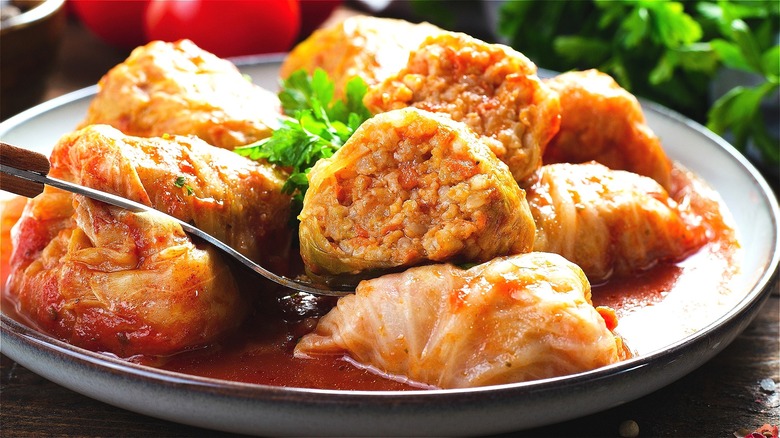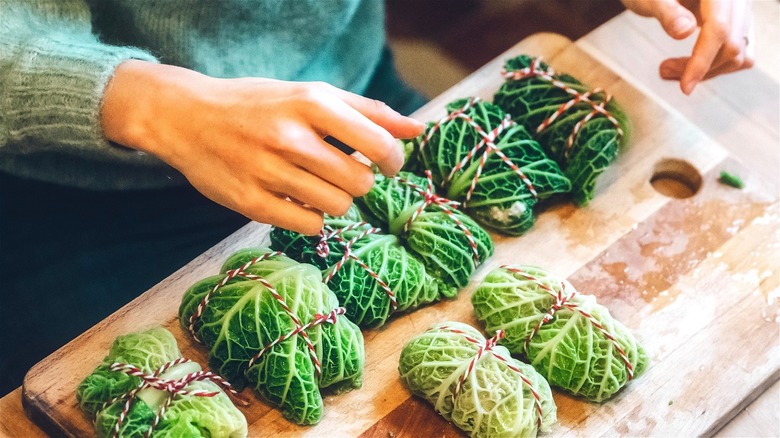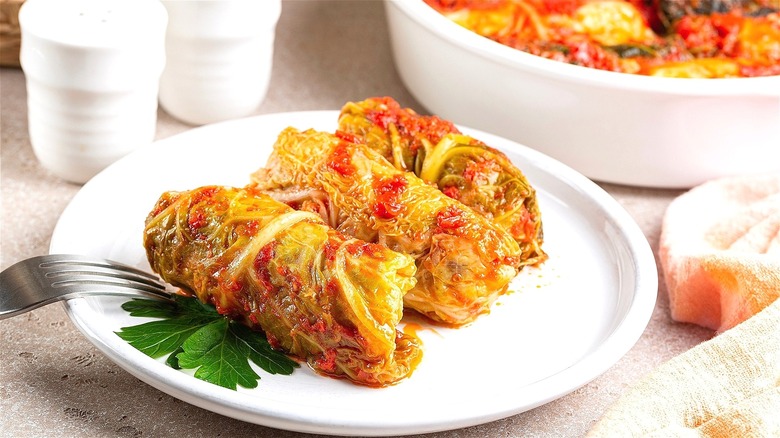For The Best Stuffed Cabbage Rolls, Opt For This Underrated Variety
Regardless of the season, there are certain recipes worth enjoying all year round. Next to spaghetti and meatballs, lemon chicken, and baked mac and cheese, stuffed cabbage rolls are a tasty, iconic dish that satisfies your recurring desire for meal nostalgia. If you've been hoping to recreate your family's generational cabbage roll recipe, there are certain ingredients you need in order to make a noteworthy version of this traditional dish.
In the most general sense, stuffed cabbage rolls are composed of ground beef, rich tomato sauce, white rice, and sturdy cabbage leaves. What makes a tasty, visually-appealing platter of stuffed cabbage rolls comes down to the central vegetable responsible for holding this entire dish together. With mindful preparation, cabbage rolls can be made with most cabbage varieties. However, if you're looking to make a supremely satisfying version of this classic meal, use savoy cabbage.
Unlike traditional green cabbage which touts thick and sturdy leaves, savoy cabbage has thinner, more delicate leaves. Savoy cabbage is easily identified by its vibrantly green wrinkled exterior and has a mild, earthy taste with just a hint of mellow sweetness. Savoy cabbage also has less of a bite than traditional green cabbage, making this variety perfect to use in your next batch of homemade cabbage rolls. Next to its versatile flavor, using savoy cabbage to make picture perfect cabbage rolls couldn't be easier.
Why savoy cabbage is the best variety to use for homemade cabbage rolls
If you're planning to upgrade your cabbage rolls in tomato and sumac recipe by swapping out green cabbage for savoy cabbage, you're in for a real treat. Not only do savoy cabbage leaves have a pleasant taste that pairs well with ground meat cooked in savory tomato sauce, but this particular type of cabbage may prove easier to use than standard green or red cabbage.
All cabbage roll recipes require boiled cabbage leaves to easily encase that quintessential beef and rice mixture. If using traditional green cabbage, the leaves are often hard to peel back when raw. In most cases, when using heartier varieties, you have to boil an entire head of cabbage in stages to effectively peel back the leaves. Luckily, savoy cabbage leaves are easy to peel before cooking and have a lesser chance of tearing or ripping upon removal.
Once you successfully remove all the workable leaves from a head of savoy cabbage, all you need to do is boil them for up to 4 minutes or until slightly cooked. Once cooled, add your meat and pre-cooked rice mixture and roll accordingly. Savoy cabbage has a small amount of flexibility that makes preparing cabbage rolls faster and easier. Breaks in the skin are less likely with rolled, par-cooked savoy cabbage leaves. Due to the adaptability of savoy cabbage, you can make your traditional cabbage roll recipe even simpler.
Use savoy cabbage for a simplified, easy-to-prepare cabbage roll recipe
Since savoy cabbage is softer and more versatile than traditional green or red cabbage, there are ways to cut back on the suggested cook time with a bit of extra preparation. To create a fast dinner, simply pre-cook your seasoned beef and rice mixture before rolling into par-cooked savoy cabbage leaves. Once prepared, cover rolls with homemade or jarred tomato sauce and bake in a 350 degree Fahrenheit oven for 25 to 30 minutes. You may want to add a bit of water to the bottom of your casserole dish so your prepared filling doesn't dry out while baking. Due to the soft and thin nature of savoy cabbage leaves, these simplified rolls are equally tender and satisfying when compared to more traditional recipes that take roughly 90 minutes to bake.
If you want even more cabbage recipes, transform your traditional cabbage roll recipe into a quick soup. For those of you after the taste and consistency of a slow-cooked cabbage roll dinner but don't want to bother preparing individual rolls, make a meaty soup base. About 15 to 20 minutes before serving, add in chopped savoy cabbage. The softer consistency of this versatile cabbage gives you the same savory flavor and texture of slow-cooked cabbage rolls in half the time.


